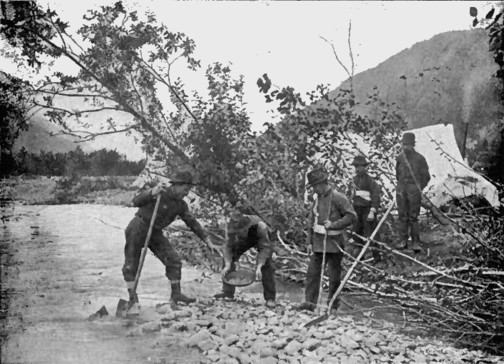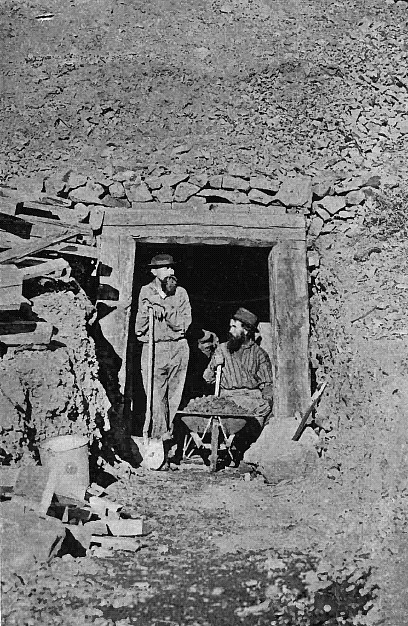Perhaps no Jesuit, since the restoration of the order in 1814, has gained so widespread a celebrity as Father De Smet. As long ago as 1843, a volume of his letters in which, with his own peculiar power of narrating and describing events and scenes witnessed by him, he gave an account of his first journey to the Rocky Mountains, was read extensively and with avidity in the United States and throughout Europe. "On the various trips undertaken, in order to advance the welfare of the Indians missions, he traveled nearly three hundred thousand miles. He collected, principally in Belgium and Holland, over one million of francs ($200,000,) besides a large number of objects for the altar, which were used in the various missions in Kansas and the Rocky Mountains. Father DeSmet visited the Indians around the Black Hills again in 1851 and 1864, and made his last missionary trip to Dakota in 1870 with Father Panken. During a period of forty years he induced more than one hundred young men to devote themselves to the service of the altar in the province of Missouri; and, finally, not to estimate the amount of good done for the Indian race through these different means, he baptized many thousands of Native Americans with his own hands.
During the year 1848, Father DeSmet spent four months in and around the Black Hills. Most probably the Indians never showed him any gold, for these two reasons: placer gold nuggets, wherever they have been found on the different streams in the hills, was deep below the surface "down on bedrock," and the Indian had no tools to work with; and gold exposed in quartz rock was tarnished by the effects of the atmosphere, so that it required an "expert" to determine the same. Undoubtedly Father DeSmet, as he was well versed in the science of geology, knew what these hills hid. But he kept this knowledge to himself until he thought silence on his part would no longer prevent white men from coming here. He wrote to his superiors about the country, but does not mention the presence of gold.
Various have been the stories told about Father DeSmet and his finding gold in the Black Hills of Dakota. It must not be forgotten that the name Dakota applied for many years not only to all the territory covered by the two Dakotas of today, but by Montana and parts of Idaho and Wyoming; and that the Wind River Mountains of Wyoming were, and by many are still called, the Black Hills; or the Black Hills in Dakota were called the " Little Black Hills" and those in Wyoming the "Great Black Hills."
Many of the stories come as near the truth as the caricature of the missionary's photo, as seen in the following illustration. But enough is known that proves that Father DeSmet was at various times in these Black Hills, and that he was well acquainted with the geology of the country. Had he lived till 1877, when the Hills were ceded by the Indians to the United States, he no doubt would cheerfully have given his information. The following story, copied from the St. Louis Globe-Democrat go to show how advantage was taken of the authority of Father DeSmet: "Early in the '60's, at a dinner given Father DeSmet, the celebrated Indian missionary, at the St. Louis University, Barney Caulfield, late member of Congress from Chicago, happened to be one of the guests entertained at the dinner. This was long before the Black Hill gold fever broke out, but the conversation turning upon the rich mineral deposits of the country, Father DeSmet, who had been in the wildest portion of the West during his missionary work, related how he had discovered most extraordinary gold deposits in the Black Hill country while digging into a mountain, and said that after finding the precious gold quartz he had again carefully covered it up. Those present at the table used every effort to induce him to locate his wonderful find, but he firmly declined to do so, giving as his reason that he did not wish his children (the Indians) to be disturbed. Although repeatedly urged to do so, Father DeSmet never divulged the secret.
"When the Black Hill gold rush fever sent so many thousands of miners to pouring into Deadwood and the surrounding area, immense deposits of gold ore were discovered around Deadwood and Central. At one of these locations, a prospector found what he believed was the identical mine of which Father DeSmet had spoken. The news went back to St. Louis, and the capitalists were excited. Hon. B. Caulfield proceeded to Deadwood, secured an option on the mine at low and favorable figures, and brought the same to St. Louis. This option he shared with Judge J. C. Normile, who in turn took into the syndicate Erastus Wells, Edwin Harrison, the Locker Brothers, then in the banking business, L. M. Eumsey, H. L. Dousman and S. C. Gaty. The money was all raised and deposited in the bank, save the subscription of Mr. Gaty. This gentleman very mysteriously withheld his share of the fund, promising to pay from day to day, all the time urgently requesting that he be permitted to continue in the syndicate. There was another gentleman ready and eager to take his place, but at his own solicitation Mr. Gaty was kept in.
Time swept by, and it was getting uncomfortably close to the date when the money must be in Deadwood to reap the benefit of the option of the mine, and still Mr. Gaty's subscription was not forthcoming. At last Judge Normile, seeing the danger of losing the prize, had Mr. Gaty's name struck off, and permitted H. L. Dousman to double his subscription, and Mr. Wm. Locker then started for Deadwood to close the deal. Under ordinary circumstances he could have made the journey in ample time, with forty eight hours to spare. It was early in November when he started, and as ill-luck would have it, a severe snowstorm set in, unusually early for that region, and Mr. Locker was detained between Cheyenne and Deadwood until thirty hours after the option had expired. The value of the property had been raised abroad and a syndicate of wealthy Californians had sent representatives to Deadwood to secure the prize if possible. They made an offer largely in advance of the price which the St. Louis party had the option to purchase and the Californians anxiously awaited the action of the St. Louis syndicate.
All of the last day that the option held good, representatives of the California party were at the Deadwood bank and others at the stage office scanning the horizon and hoping that the St. Louisans would not put in an appearance, yet fearing that they might. It was a day of intense excitement to them, as they afterwards acknowledged, and when the sun sank below the western horizon and the St. Louisans came not the hearts of the Californians were gladdened. They immediately closed the contract at double the figure at which the mine could have been secured by the St. Louis syndicate, paid the cash, and the prize was theirs. "By this unfortunate delay the St. Louis party lost perhaps the richest mine in America! When the Californians secured it they immediately stocked it for ten millions of dollars." So far the story is that the price paid was $400,000 and today the mill which was to reduce the inexhaustible body of ore, is running continuously upon ore taken from the Deadwood-Terry mines owned by the Homestake Company.
Return
to The South Dakota Page:
South Dakota Gold Rush History



